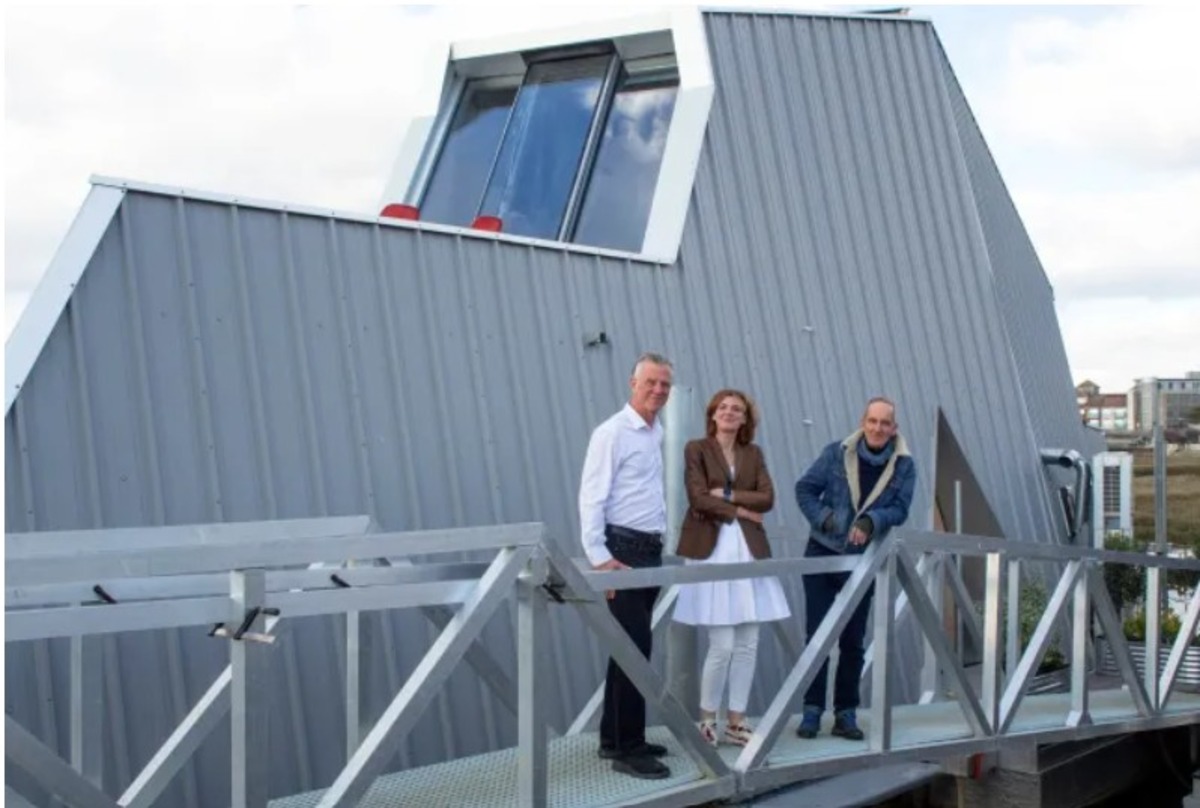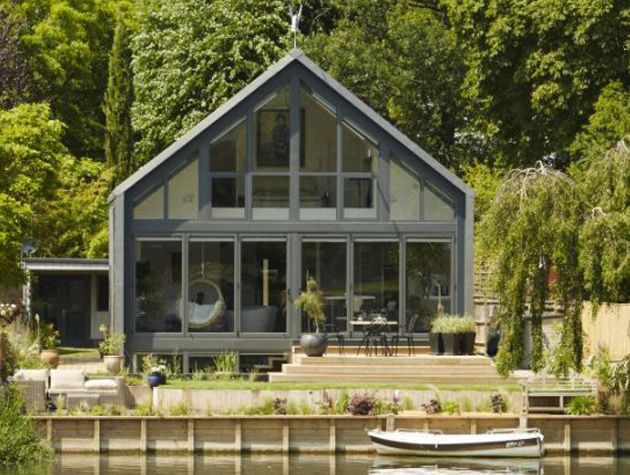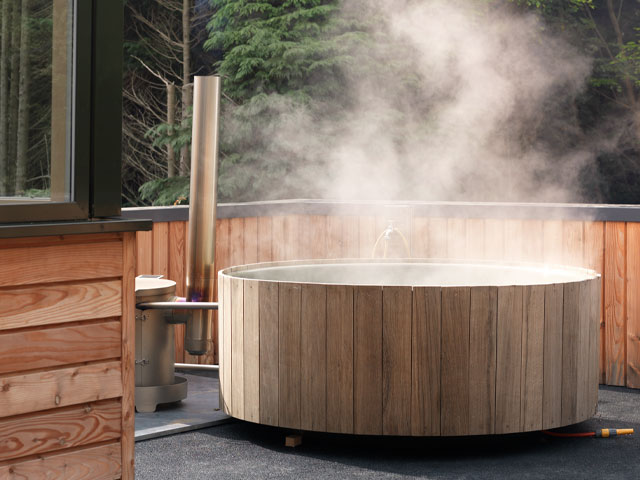A floating house in Worthing
Will this ambitious home sink or swim? Discover more about one of Grand Designs' most difficult projects yet
Howard and Sarah had all the expertise to build an incredible home, but did they have the sheer willpower and inner strength to tackle such a challenging project? Let’s find out…
Architect Howard and interior designer Sarah are a match made in self-building heaven – but could this be a bridge too far?
The couple together have spent 30 years creating challenging homes for themselves and clients in unlikely places, including a former World War Two radar station on the Isle of Wight.
Their perfect project is something with unimaginable difficulty and impossibility, but with a spark of interest such as an incredible location.
For the last fifteen years, the couple have lived with their children in a small town on the south coast near Worthing, which they love.
They’re currently renting a four-bedroom family home, and with their children off to university, taking gap years and doing A-levels, now is their time to get on with their next project.
A tidal river bank
We first meet the couple in February 2022 when their latest plan is hatched: to build an astonishing new home on a tidal riverbank, a stone’s throw from the Channel and sitting amongst the houseboats on the estuary.
“Everything about this is a bit wild and a bit hairy,” Kevin exclaims, staring at their upcoming next-door neighbour, a 1950s German torpedo boat.
The derelict World War Two landing craft on a river plot has cost them £255,000 but is beyond restoration, so will need to be completely cleared before work can begin on the new floating home project.
The plan is to then build a new structure in its place – not a houseboat, but a floating family home that will sit on a floating platform.
The highly engineered structure will be drenched in sun, with views out and over the estuary.
It’ll have a below-deck cinema room and office space, with four cabins used for bedrooms and three bathrooms.
The question on our lips has to be: why? With so many other, less problematic projects out there, what made the couple opt for this…
Sarah explains: “We’ve spent all of our lives looking for exciting projects and quietly, while at the same time becoming addicted to this location, which is amazing. It’s where our children have grown up, so we were looking for our next challenge in this location.”
Howard adds: “All of our projects are about finding something that we can transform into something magical – and this, for us, is it.”
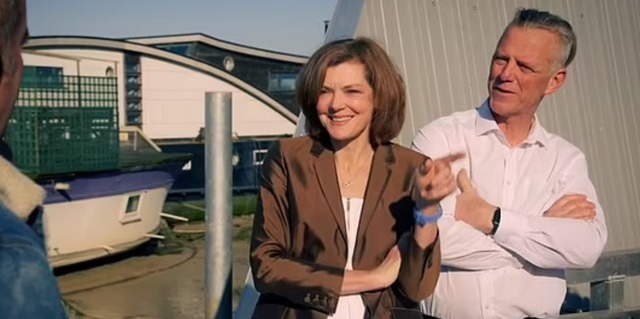
Photo: Channel 4 via Daily Mail
All bets are off on the floating house
The first challenge is figuring out how to extract the landing craft from the mud on the bank.
It’s already disintegrating, so needs to be completely removed.
The plan is to construct 16 enormous floats from polystyrene off-site, and a hugely complicated steel frame.
The pieces will then be built together, and the frame assembled on-site on the ever-shifting tidal bed.
At low tide, the floats will be moored in the mud, while at high tide the first section will go into the river, making way for other sections.
The vaulted steel space at the top of the structure will have an enclosed living, kitchen and dining space.
It will also have a large outdoor deck at the rear, providing magical, ever-changing views of the estuary.
There will also be a hydraulic window that will provide access to the foredeck.
The budget for the construction is £385,000, with an upper limit of £450,000.
The couple sold their house to fund this project, as they couldn’t get a mortgage for it.
The plan was to be living in the floating house by 2023.
With an 18-month project time, Howard and Sarah will also be the project managers.
Kevin believes the couple may have bitten off more than they can chew, adding: “They’re building on mud, which is so unpredictable and subject to the tides ebbing and flowing multiple times a day.
It’s impossible to predict how this project will go – all bets are off.”
Stuck in the mud
A big crew of helpers join Howard and Sarah to help demolish the eighty-year-old landing craft – costing them £25k in the process.
The labour is a big part of the cost, but the skips are also expensive for holding materials.
Howard has bought a pedestrian-operated, remote-control crane with a sky hook to help with the process and the build to come – but it cost £25k.
Fast forward to May 2022 and the extraction from the mud is far from complete. Sarah puts it into words: “Every morning we’ve got to get up and do something that we’re just not in the mood for.”
The delays now mean the construction of the floating home is going to be put off until next year.
Howard explains “We decided to defer construction in order to concentrate on getting the boat out ourselves, safely and slowly.”
Six months after the process began, in September, the landing craft is finally out of the mud.
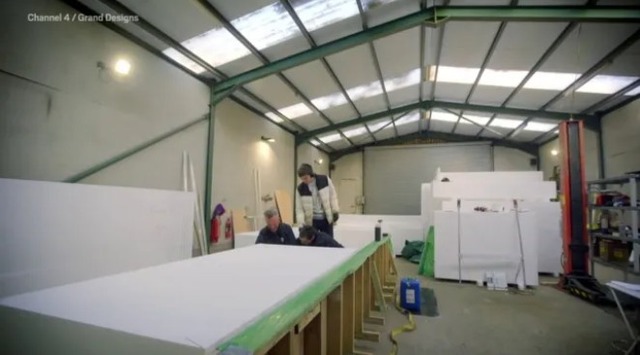
Photo: Channel 4 via Metro
Floating house structure
One year into the project, in February 2023, the couple begin fabricating polystyrene floats at a workshop in Sussex.
While polystyrene was chosen for its floating ability and lightweight feel, when dealing with 200 cubic metres of the stuff, it ends up weighing more.
The combination of strength and durability means they are able to walk on it while the steel works are erected.
Meanwhile, the steel structure is being fabricated in Chichester.
Thomas Male, the Steel Fabrication Director, says of the project: “Polystyrene, to me, doesn’t seem solid enough. Polystyrene might float, but steel sinks.
“We are mad to do this job, really. Normally we would supply and install a job, but Howard was adamant that he would install it himself.
“We’ve just got to wait and see how they get on.”
It doesn’t help that constructing a steel frame strong enough to withstand knocks from unknown objects below adds absurd levels of complexity.
The acute and obtuse angles of the structure also mean that everything is unique, and each drawing has a unique reference number.
These then need steel plates fitting at all different mm-perfect positions.
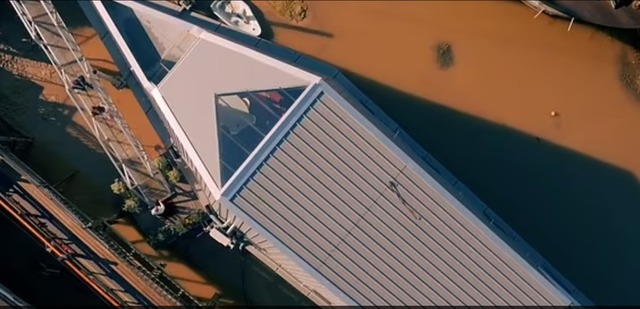
Photo: Channel 4 via Daily Mail
Installation of the floating house
In June 2023, Kevin returns to the site, where for the first time the floats and steels are on-site, ready to be installed onto the riverbed.
This is 18 months into the project, when Howard and Sarah thought they’d be living there.
The plan is to lift each polystyrene platform up, turn it with the crane over to the river, but the crane has limited reach, and they can only position four floats at a time.
Thanks to the water, mud, tide and wind, there is also a real risk of the ties distorting and ripping, drastically hindering progress.
There is just one hour before the tide comes in.
With incredible luck, the first of the nine beams is fitted within minutes – but there is a problem: it’s been put in the wrong way round.
The tide is about to come in, so the rush is on to reposition it correctly and get the other eight beams on. Somehow, they manage to get the first four floating sections complete.
By July 2023, the first phase, and the first quarter of the boat, is complete.
In September, they are preparing for the winter, and the trickier sections.
The plan is to get the cladding on so that they can work through the winter.
Remarkably, within six weeks, the first-floor steels are in. However, more serious setbacks are showing.
After heavy storms in October 2023, the couple decide to prioritise permanent moorings to ensure the structure doesn’t drift out to sea.
However, getting the designs for this engineered and fitted will take time.
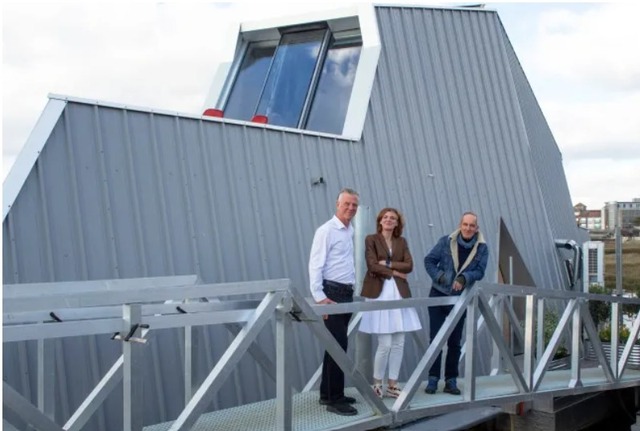
Photo: Channel 4 via Metro
A new addition to the riverbank
In April 2024, as Howard and Sarah’s toil on the river enters its third year, it has an almost watertight structure to show for it.
Resembling a 21st-century Royal Navy warship, the structure is raising eyebrows across the local community.
After the mooring shenanigans cost the couple five months, they now need to fit it out. They need to be in by the 5th of July, as their landlord wants them to move – so they have 10 weeks.
Howard welds his own aluminium bridge to provide access from the riverbank to the floating house. Below decks, his friend Luke is grappling with installing rectangular bathroom units into a triangular space. Meanwhile, Sarah has started a woodworking course in the evenings to create some striking storage for their new home.
The new kid on the block
By February 2025, there is a new floating house on the block. “It’s no longer like visiting grunge-central on the mud, it’s more like a secret naval base,” Kevin exclaims.
The entrance immediately showcases the elegance, with a stunning hallway lined with tiger bamboo.
The aluminium staircase leads into a soaring living space.
The triangular rooflight is the star of the show – it’s like walking into a steel cathedral.
The kitchen island–come–standing desk–come–ping pong table is impressive, as is Sarah’s stunning joinery storage that she calls “the pinnacle of her woodwork journey so far.”
Downstairs overlooks the river, with the tide coming in and the boat rising, making the space feel at one with nature.
The cinema room and cabins are stunning, with the latter being timber-lined with a crafted effect, making them really feel like they’re on a boat.
This home is a triumph of architecture, engineering and imagination.
At completion, the costings worked out at £465,000, but Sarah believes they have a bit more to do.
They have sacrificed three years of their life – as well as stamina, patience, will and energy. But they maintain that the joy is far greater than the difficulty.
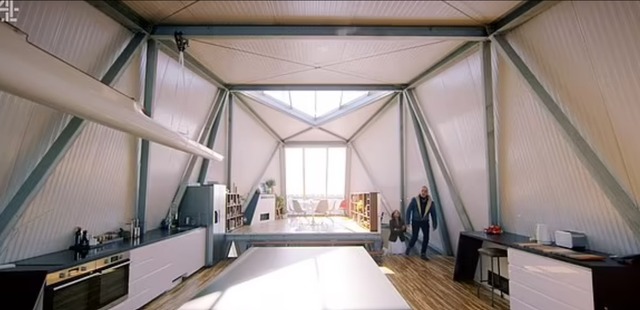
Photo: Channel 4 via Daily Mail
READ MORE

